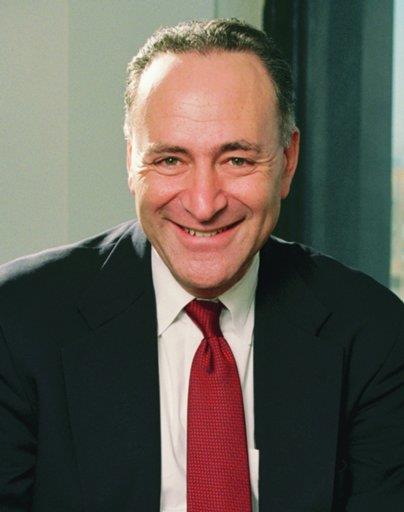
AFTER SCHUMER’S URGING, DRONE GEO-FENCING PROPOSAL PASSES THE SENATE; NEWTECHNOLOGY COULD PROHIBIT DRONES FROM FLYING NEAR AIRPORTS, SENSITIVE AREAS, SPORTING EVENTS & ABOVE 500FT
Schumer Pushed For Drone Safety Language In FAA Reauthorization Legislation That Has Now Passed The Senate; Senator Cited This Past Weekend’s Drone Collision With British Airways Plane, NYC Near-Misses & Pilot Sightings When Making Final Push For Passage
Geo-Fencing & Other Similar Technology Solutions Prevent Drones From Flying Where They Shouldn’t & Can Help Stop Drones From Colliding With Planes
Schumer: Geo-Fencing Could Soon Become Law Of The Sky
U.S. Senator Charles E. Schumer recently announced that a requirement to develop new safety standards for drones – that could include technology like geo-fencing that would keep drones away from sensitive areas -- passed the Senate 95-3 as part of the FAA Reauthorization Bill. Schumer helped lead the charge to include the drone safety language in the Federal Aviation Administration (FAA) Reauthorization Bill and cited this past weekend’s drone collision with a British Airways jet when making his final push for the geo-fencing proposal that has now passed.
“The drone that just crashed into a British Airways plane showed us yet again, there is no time to waste in getting geo-fencing technology off the ground here in the U.S.,” said U.S. Senator Charles Schumer.“Now that this drone-safety language has passed in the FAA bill, geo-fencing drone technology could soon be installed on every new drone, helping to stop them from flying near airports and other sensitive areas, while still allowing hobbyists to fly them in safe places.”
The bill would require the FAA, in collaboration with industry and other stakeholders, to establish new safety standards for drones that Schumer says should support geo-fencing technology. In developing the standards, the FAA is required to consider technologies related to geographic limitations and altitude limitations, like geo-fencing and other similar technologies. Geo-fending could help to prevent drones from flying into “No Fly Drone Zones,” like airports, the Pentagon, major parades, large sporting events—such as the U.S. Open---and even planes themselves.
Geo-fencing or other similar technology, which Schumer has long-advocated for, limits where unauthorized drones can fly through the installation of built-in software, firmware and GPS tracking in the device. The technology helps take human error out of the equation. Manufacturers are already experimenting with placing this type of technology in their drones, however, Schumer said that all manufacturers should be required to take all reasonable steps to implement the software right away. Schumer said that, with this legislation, geo-fencing could be one step closer to becoming a requirement for drones.
Drones are unmanned aircraft systems (UAS) that fall under three categories denoted by the Federal Aviation Authority (FAA): civil, public and model aircraft. The public unmanned aircraft systems are used by government agencies, law enforcement agencies and research institutions to aid in their operations. Schumer said that drones are an incredibly important technology, and are helpful in collecting data, aiding with border patrol operations, agriculture, training the military and more.
The civil unmanned aircraft systems and the model aircraft systems provide opportunities for civilians to use drones recreationally, and for drones to be used for research and development. Schumer supports the use of drones under all of these categories, but said that there must be clear limits to their usage when privacy and safety are threatened. Schumer noted that drones have commercial applications that make them useful in terms of agricultural development, real estate sales and search and rescue missions. Specifically, drones can help farmers monitor their crops more effectively and may help realtors sell real estate by providing better photographs of for-sale properties. Drones can also aid in search and rescue missions by locating missing individuals. Schumer said that there are innumerable benefits to drone technology, however, there are also consequences to the lack of regulation.
The FAA is charged with developing general, binding rules for integrating drones into the national airspace. In light of a number of near-misses at New York City airports as well as numerous privacy concerns over the years, Schumer has long been an advocate for clearer guidelines on drone use. Since the FAA Modernization and Reform Act was passed in 2012 and established “a special rule for model aircraft,” Schumer has urged the FAA to release its proposed rule, which would distinguish between hobby and commercial drones, and outline the legal and illegal uses of commercial drones. On February 15th, the FAA released its draft rule on drones; Schumer said this was a good first step towards airspace safety, however, geo-fencing or other similar technological requirements are still necessary to improve the safety of our skies.
According to the FAA, reported pilot sightings of unmanned aircrafts have increased over the past year from a total of 238 in 2014 to more than 650 by August 9th2015. Schumer said that these drone sightings are extremely troubling because a collision could put hundreds of airplane passengers and pilots in real danger. There have been several reported near-misses involving drones and airplanes in the New York metro area, impacting all three major airports.
###